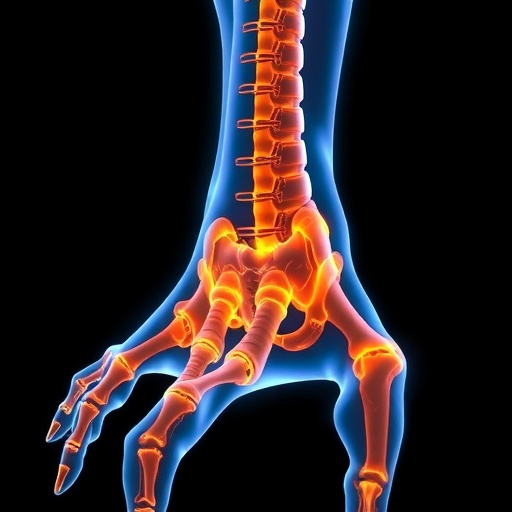Emerging research highlights the protective effects of Tanshinone I, a bioactive compound derived from the traditional Chinese herb Salvia miltiorrhiza, in combating ferroptosis—an iron-dependent form of regulated cell death. This pathway has been implicated in a plethora of diseases, including neurodegeneration and organ failure, prompting scientists to explore novel therapeutic approaches to mitigate its detrimental effects. A groundbreaking study by Lu et al. profoundly addresses this issue by demonstrating Tanshinone I’s potential to inhibit ferroptosis, particularly in the context of steroid-induced osteonecrosis of the femoral head, a debilitating condition affecting bone health.
Steroid-induced osteonecrosis poses a significant challenge in orthopedics, primarily due to its complex pathophysiology. The condition is often a consequence of prolonged steroid administration, leading to compromised blood flow to the femoral head, subsequent bone cell death, and eventual structural collapse. Current treatment options are limited, making the investigation of alternative treatments both timely and critical. The findings in this study illustrate a promising avenue toward alleviating the devastating effects of this condition through the modulation of ferroptosis.
In their meticulous research, the authors focused on the underlying mechanisms of Tanshinone I’s action, particularly its role in the Nrf2/SLC7A11 axis. The Nrf2 (nuclear factor erythroid 2-related factor 2) pathway is renowned for its involvement in cellular defense against oxidative stress. Tanshinone I appears to activate this pathway, resulting in an upregulation of the SLC7A11 gene, which encodes a cystine/glutamate antiporter. This transport protein plays a crucial role in maintaining cellular redox homeostasis by facilitating the uptake of cystine, a precursor for the antioxidant glutathione.
One of the study’s compelling findings was the direct correlation between Tanshinone I treatment and increased glutathione levels. This increase is pivotal, as glutathione acts as a buffer against oxidative stress, an initial trigger of ferroptosis. The authors observed that Tanshinone I effectively restores glutathione levels in osteoblastic cells subjected to steroid-induced oxidative conditions, thereby diminishing the likelihood of cell death through ferroptosis. Consequently, the protective effects of Tanshinone I extend beyond mere antioxidation; they encompass a broader spectrum of cellular health and integrity.
Furthermore, the researchers employed various in vitro and in vivo models to substantiate their findings. Using osteoblastic cell lines, they induced ferroptosis through exposure to steroid hormones and subsequently treated these cells with Tanshinone I. The results were remarkable; the compound not only repressed cell death but also countered the morphological changes typically associated with ferroptosis, such as mitochondrial shrinkage and membrane rupture.
The in vivo component of the study was equally revealing. The researchers utilized a steroid-induced osteonecrosis model in rodents, where treatment with Tanshinone I significantly improved bone microarchitecture and reduced the incidence of osteonecrosis. These compelling results underscore the translational potential of Tanshinone I as a pharmaceutical agent capable of mitigating adverse effects associated with steroid therapy, offering hope to millions affected by steroid-induced pathologies.
Another crucial aspect of the study is the emphasis on the multifactorial nature of osteonecrosis. While steroid administration is a primary risk factor, other elements contribute to the disease’s onset, including genetic predispositions, environmental triggers, and metabolic imbalances. Therefore, Tanshinone I’s broad-spectrum action, focusing on ferroptosis and oxidative stress, suggests that it could play a role in a more extensive therapeutic regimen aimed at improving patient outcomes.
While the results are promising, the authors hasten to note that further studies are necessary to fully elucidate the molecular mechanisms through which Tanshinone I exerts its effects. Future research endeavors should aim at exploring the compound’s efficacy in both monotherapy and combination therapy settings to establish optimal therapeutic strategies. Additionally, understanding the pharmacokinetics and pharmacodynamics of Tanshinone I in human subjects will be pivotal in determining appropriate dosing regimens and possible clinical applications.
The possibility of harnessing a natural compound like Tanshinone I to treat steroid-related conditions holds particular appeal. With the increasing prevalence of chronic illnesses necessitating steroid therapy, the availability of a safe and effective adjunct therapy could revolutionize clinical practices. The integration of herbal medicine into modern therapeutic frameworks could bridge the gap between traditional knowledge and contemporary science, fostering a holistic approach to patient care.
As awareness grows regarding the therapeutic ramifications of natural products, this study marks a significant leap in biochemistry and pharmacology. The elucidation of the Nrf2/SLC7A11 pathway’s involvement in Tanshinone I’s protective effects against ferroptosis represents an exciting frontier in therapeutic development. As researchers continue to delve into the intricate relationships between natural compounds and disease mechanisms, the potential for groundbreaking treatments lies on the horizon.
In conclusion, the study by Lu and colleagues provides critical insights into the protective mechanisms of Tanshinone I against ferroptosis in the context of steroid-induced osteonecrosis. Through the activation of the Nrf2/SLC7A11 axis and subsequent enhancement of glutathione levels, Tanshinone I emerges as a powerful candidate for further investigation as a therapeutic agent. The convergence of traditional Chinese medicine and modern biochemistry invites further exploration, promising a future laden with innovative solutions for pressing medical challenges.
Subject of Research: Ferroptosis and its inhibition by Tanshinone I in steroid-induced osteonecrosis of the femoral head.
Article Title: Tanshinone I Represses Ferroptosis to Protect Against Steroid-Induced Osteonecrosis of the Femoral Head by Activating the Nrf2/SLC7A11 Axis.
Article References:
Lu, L., Zhou, M., Zhang, X. et al. Tanshinone I Represses Ferroptosis to Protect Against Steroid-Induced Osteonecrosis of the Femoral Head by Activating the Nrf2/SLC7A11 Axis. Biochem Genet (2025). https://doi.org/10.1007/s10528-025-11247-4
Image Credits: AI Generated
DOI: 10.1007/s10528-025-11247-4
Keywords: Tanshinone I, ferroptosis, steroid-induced osteonecrosis, Nrf2, SLC7A11, glutathione, biomarker, traditional medicine, oxidative stress, treatment, pharmacology, biochemistry, natural products.





